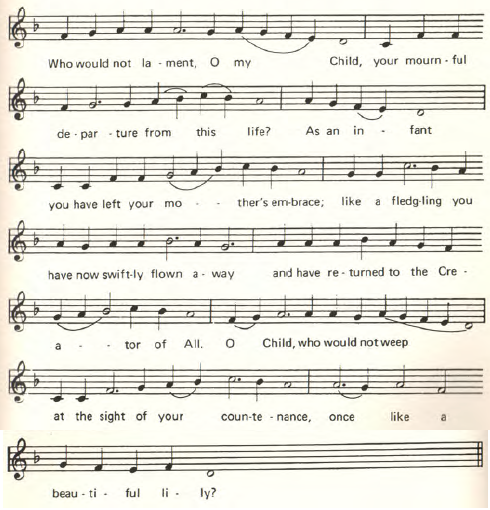Singing the Burial Service (Funeral) for a Young Child
Listen to the audio version of this lesson
This article explains how to lead the singing of our burial service (funeral) "for an infant or young child" (generally, under the age of seven or so). For more about this service, see this article.
This part of the funeral service can be found on pages 127-146 in our current funeral book, The Office of Christian Burial (1983, PDF).The service "in the home"
This part of the service (once conducted in the home of the departed) is usually held in the funeral home on the morning of the funeral. It is essentially the same as that for an adult, consisting of:
"Blessed is our God"
"Holy God, Holy and Mighty" and the rest of the beginning prayers
The troparia for the deceased ("With the souls of the just brought to perfection....")
The Litany for the Deceased
Dismissal (and Eternal Memory was usually added)
The litany petitions and the prayer at the end of the litany are specific to a child's funeral (though the people's parts here are identical to those for an adult). and there is no Gospel reading after the service. Then the body is taken to church for the funeral. (See Singing the Funeral Service, Part I if you need help with this part of the services.)
The service in church
The funeral procession makes its way to the church, and then the body is taken into the narthex (vestibule or "porch") or, more commonly, into the nave of the church. Here begins the service "in the church" - what we often think of as the funeral proper.
"Holy God" is sung as the body is taken into the church, but there is no Gospel reading.
The funeral service begins with an opening blessing, and the chanting of Psalm 90 (a psalm asking God's protection). In the full service for a child's funeral, this may be followed by the singing of the Canon for a Departed Child, with the refrain, "O Lord, rest the soul of this child." This canon is entirely omitted from our current funeral book, but will likely be added when a new book for the child's funeral is officially promulgated.
Then the priest exclaims, as he does at the end of the troparia and kontakion of the Divine Liturgy:
For you are holy, our God, and you dwell in the holy place, and we give glory to you, Father, Son, and Holy Spirit, now and ever and forever.
The cantor and people respond, "Amen", and begin singing "Holy God", just as at the Divine Liturgy. This is followed by the readings (a prokeimenon, epistle, Alleluia, and Gospel). The faithful may sit for the homily if there is one. The Litany for the Departed is NOT sung as it is at an adult's funeral.
After the Ambon Prayer of the Divine Liturgy, or immediately after the Gospel (and homily) if there is no Divine Liturgy, the Hymns of Farewell for a Departed Child are sung, using a special melody from the feast of the Dormition called O preslavnaho čudese. These can be found on pages 139-141 in the funeral book. (Listen to these hymns - listen to the O preslavnaho čudese melody in Slavonic.)


The hymns at Glory... Now and ever are sung in the ordinary Tone 6 samohlasen melody:


During the singing of these hymns, those present come forward to say their farewells to the child who has died, and venerate the cross held by the priest.
After the dismissal, the priest intones:
O blessed and ever-memorable child (Name), may you be remembered forever.
and "Eternal memory" is sung as usual.
The service "at the grave"
The interment portion of the funeral is identical to that for an adult, except that "O gaping earth" is not sung, and the litany petitions and prayer (if a panachida is celebrated) are those for a child.
A word about choices for melodies
Any funeral is a difficult thing, and the funeral of a child doubly so. The differences between the funeral services for an adult and a young child show forth our church's theology on the meaning of death in these two cases. So it would be entirely appropriate, if a Divine Liturgy is celebrated, to use the "ordinary" melodies for the hymns of the Divine Liturgy, rather than the funeral melodies. This is a decision that should be made with the pastor in each case.


